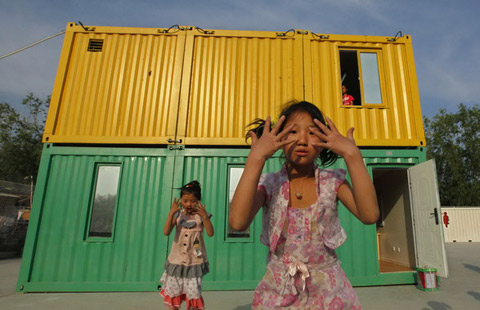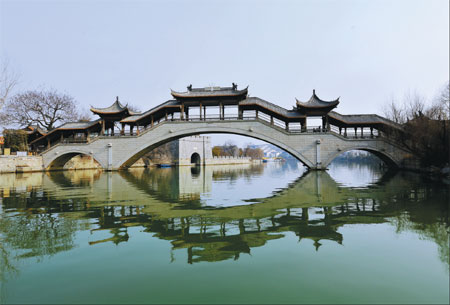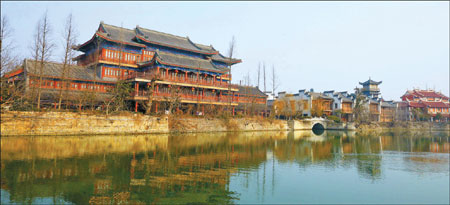Where culture flows
Updated: 2014-04-03 08:21
By Wang Qian (China Daily)
|
|||||||||||
The Grand Canal's heritage has prompted over 80 sites to seek a shared UNESCO listing. Wang Qian follows the ancient passageway's course into the future.
Xu Deguang still often reminisces about chanting songs to lead boatmen as they hauled barges through dangerous shoals and rapids along the Beijing-Hangzhou Grand Canal.
The 97-year-old is believed to be the only living inheritor of haozi, a type of folk music sung to synchronize boatmen in Zaozhuang city in southwestern Shandong province, where a significant section of the canal still functions.
"In the past, navigation depended on the song-leader's ability," Xu says.
"He was vital and decided the rhythm and tone, depending on water flow and rowing pace. This enabled the others to harness their collective strength according to the rhythm."
Unlike other places' boatmen's ballads, whose lyrics are mostly improvised, the lyrics of Zaozhuang's haozi are said to have been standardized by Qing Dynasty (1644-1911) Emperor Qianlong. Haozi is now a provincial-level intangible culture heritage.
"Previously, haozi was only used for boats that delivered grain and goods for the royal families from south to north via the canal. The lyrics were approved by the emperor and can't be changed," Xu explains.
There are 11 main haozi forms in Zaozhuang, each with different lyrics and functions. They include those for punting, rowing, mast-hoisting and sail-spreading, shouldering, breaking and overcoming rapids.
Xu grew up in a poor family near the canal. He started to help his parents at age 7 and learned from a veteran lead singer who once worked on the imperial boat.
"The lead singer requires not only a good memory and lungs but also enough knowledge of potential dangers. Few people could do it," Xu says.
But he was well rewarded and enjoyed a good reputation.
"A boat loaded with 50 tons was generally hauled by seven men. It was very cool when I sang and others responded in different voices," he recalls.
"The lead singer earned the biggest salaries among boatmen - about 15 dayang (a Republic of China silver dollar) a month - enough to feed the whole family then. Other boatmen were only paid 4 dayang."
The trade began to vanish when engines started to become more common in the 1950s. "I've seen ups and downs of canal life. I just hope more young people can know the art form and understand bygone days."
The 2,000-year-old Beijing-Hangzhou Grand Canal, the world's longest and oldest artificial waterway, has witnessed much of China's history and is celebrated for its myriad traditional cultures.
According to The Summary of the Ancient Chinese Novel published in 2005, over 70 percent of novels from the Ming (1368-1644) and Qing (1644-1911) dynasties depicted stories set along the Grand Canal during Chinese literature's heyday.
Zaozhuang is the first Shandong city the Grand Canal enters.
"The opening and flourishing of the Grand Canal not only turned Zaozhuang into a communication and economic hub during the Ming and Qing dynasties but also has left rich cultural legacies," Zaozhuang's cultural relics bureau director Shao Lei says.
The city now contains 406 intangible culture heritage items above the municipal level, including haozi, Liuqin Opera, storytelling in local dialect with drum accompaniment and Zaozhuang shadow puppetry.
"The canal caused the country's businesspeople to converge in the city, bringing diverse cultures and folk arts," Shao says.
The Zaozhuang government built a 10,000-square-meter national expo park for intangible cultural heritage in the ancient town of Tai'erzhuang alongside the canal.
Qing Emperor Qianlong once praised Tai'erzhuang as "the world's most affluent town". But it was destroyed during the War of Resistance against Japanese Aggression (1937-45).
Since 2009, 1.7 billion yuan ($278 million) has been allocated to restore the town to its former glory.
"The reappearance of traditional cultures and crafts is important to the town's reconstruction," says the town's management committee director Wang Guangjin.
Wang says 156 national- and provincial-level heritage items from across the nation are displayed in the park.
They include Beijiang clay sculptures, Luzhou oil-paper umbrellas and traditional New Year woodprint paintings from Shandong's Weifang.
Tourists can see how these handicrafts are created or try making their own.
Folk artists are also paid to perform in the town. Most are inheritors of centuries-old traditions at risk of vanishing.
Zhu Siquan was overjoyed when he was invited to the town to present Lunan dagu - storytelling in Zaozhuang dialect performed while beating a drum and two steel plates.
The performance art can be traced back to 400 years ago and was once very popular in areas around the canal, especially in northern China.
"About 40 years ago, dozens of people would gather in a teahouse every night and watch the show, which generally lasted two hours," says the 63-year-old, who began to learn the craft at age 13 and practiced it for almost half a century.
"The audience erupted into applause as soon as I stepped onstage. Some would come every day, since it usually took a month to finish a book."
Most of the stories are adopted from ancient Chinese literature, and told with rhymed lines and expressive body language.
Zhu lost most of his business 10 years ago and had to open a clothing shop to feed his family.
"I'm so glad I can find a new stage here where tourists can experience the ancient art's glory," Zhu says.
He earns 2,000 yuan a month.
Residents and farmers outside the town have organized more than 200 folk troupes. They've given over 6,000 performances to Zaozhuang's villagers and students, the municipal government reports.
"It's a good way to enrich our leisure and protect dying folk arts," says 62-year-old Yan Jingli, from a troupe in Yicheng district's Gushao township.
After retiring from the municipal opera troupe, Yan has volunteered to teach Liuqin Opera in a troupe of about 30 people ages 20 to 65.
"Most are nearby farmers," Yan says. "They're amateurs and can't perform very professionally. But it's a very good start."
Contact the writer at wangqian2@chinadaily.com.cn.
|
The opening and flourishing of the Grand Canal during the Ming (1368-1644)and Qing (1644-1911)dynasties has left rich cultural legacies in Zaozhuang in Shandong province. Photos by Ju Chuanjiang / China Daily |
|
Folk artists perform Liuqin Opera at a traditional theater in Tai'erzhuang. |
|
A reconstructed historical buidling stands on the bank of the Grand Canal in Tai'erzhuang. |
(China Daily 04/03/2014 page18)
Today's Top News
Turkey expects China's high speed rail investment
Search for MH370 'must not ease up'
China announces economic package
2 more human H7N9 cases in China
Full text of China's policy paper on EU
Xi's trip builds bridge to Europe
China Daily wins award in UK
NATO halts co-op with Russia
Hot Topics
Lunar probe , China growth forecasts, Emission rules get tougher, China seen through 'colored lens', International board,
Editor's Picks

|

|

|

|

|

|








